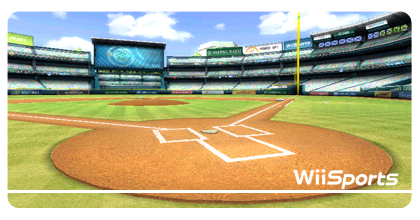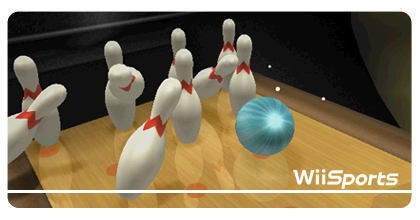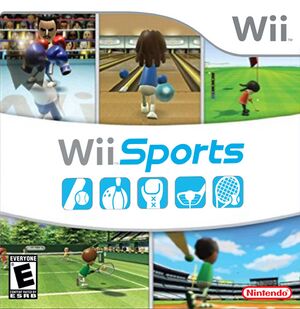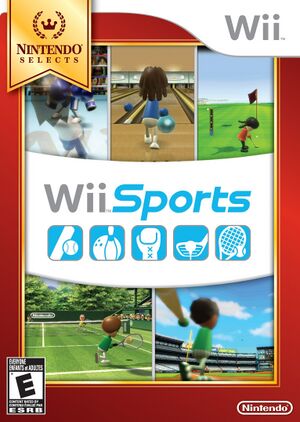Wii Sports
| Details | |
|---|---|
| Developer(s) | Nintendo EAD |
| Publisher(s) | Nintendo |
| Release date(s) | |
| Platform(s) | Wii |
| Rating(s) | ESRB: PEGI: CERO: |
| Input(s) | Wii Remote Wii Remote + Nunchuck |
| Game ID | RSPE01 |
| Game chronology | |
| Previous game First game in series |
Next game Wii Sports Resort → |
| On affiliated sites | |
| Walkthrough | |
- This article is about the video game, and should not be confused with the series of the same name.
Wii Sports is a game released in 2006 as a launch title for the Wii console. It was also a pack-in title for the Wii in most regions, except for Japan. This is the first game ever in which Miis appears. It has sold nearly 83 million copies and is the fourth-best selling game of all time as of 2024, as well as Nintendo's best-selling game.[1]
The game shortly became a success and later got sequels as well as a few spin-offs, turning into a series with multiple games such as Wii Sports Resort, Nintendo Switch Sports and Pilotwings Resort. A remake of Wii Sports released in 2013 on the Wii U titled Wii Sports Club.
Gameplay
Wii Sports consists of multiple different modes, with the five main modes being Tennis, Baseball, Bowling, Golf, and Boxing. There is also a Training mode in which basic skills for each of the modes can be practiced. All modes use the Wii Remote's motion controls and Boxing uses the nunchuck attachment. The player uses the controller to perform actions just like in real-life sports, such as using the remote as a golf club, or a boxing glove. The rules of the games are simplified to be easier for first-time players, as well as younger players.
Every day, the player may attempt a Wii Fitness test, which has the player play a random 3 of the training modes in sequence. The player is then given a fitness age for that day based on their score. Some of the training modes are modified slightly, so that they last longer.
Miis are awarded skill points from winning games, but lose points from coming in last place, or sometimes 2nd or 3rd place as well. The amount of points won or lost depends on various factors such as the skill of the other players, the difficulty of the game, and the amount of skill the player already has. If the player possesses a large enough amount of skill more than the other players, no skill will be awarded when winning. Miis have separate amounts of skill for each of the five games. Skill is attributed to a Mii, however, skill is not transferred when a Mii is imported to another console.
If there is an insufficient amount of players in Tennis, Boxing, or Baseball, one of 60 CPU players will be used. Each CPU player has a unique but unchanging skill level. Players are matched with CPU players of a similar skill level. Once the player's skill level goes up, new CPU players will be played against. Golf and bowling can be played alone, as in real-life, with the object of the game then being to obtain a new personal best.
Wii Sports Club is a remake of Wii Sports where all five sports use the Wii MotionPlus accessory, and boxing makes the player use a second Wii Remote instead of a Nunchuk.
Development
With the release of the Wii, Nintendo decided to reach a new type of public, being people who do not play video games often, and to do so, needed both softwares and games that were accessible enough so that both old and new players could enjoy them. Wii Sports was then designed, with the game being a simple title meant to introduce the Wii and offer something for people who just started to play videogames and old time players, with sports being chosen as the main theme of the game due to being a familiar topic with most people. Rather than featuring realistic graphics however, the game was designed to have a simple art direction, matching the game itself desinged to be very simple so that anybody could play the game and have a good time doing so, with the sports themselves being simplified a bit, with action like running towards the tennis ball in Tennis being automaticly controlled.

At one point in development, Super Mario characters were envisioned to replace the Miis (at the title refered to as Kokeshi Doll), but most of the staff prefered the Miis being used rather than the Mario character, leaving the idea to be scrapped.
The game used the Wii Remote's motion control in order to make the action that have to be done in game very intuitif, the player just having to mimick the real-life counterpart of the sports being played. Due to Nintendo not expecting players to purchase the Wii solely to play Wii Sports, they bundled the game with the console in all regions except Japan, believing that players would be more likely to play Wii Sports if the game was a pack-in title and feeling that players that enjoyed the game would increase its popularity by word of mouth. Initially, Shigeru Miyamoto and Nintendo President Satoru Iwata were hesitant to include the game as a pack-in title, but were convinced by Nintendo of America President Reggie Fils-Aimé.
The first sport included in Wii Sports, being Tennis, was revealed a bit before the Electronic Entertainment Expo Media and Business Summit of 2006, under the name Wii Sports: Tennis, with Nintendo later announcing during a press conference that the game would be a part of a sports package for the Wii.

Iwata then introduced during the exposition this sports package as Wii Sports, stating that it would include tennis, golf, and baseball, the games being featured as both a video demonstration and an on-stage playable demo featuring Satoru Iwata and Reggie Fils-Aimé in a doubles tennis match against Shigeru Miyamoto and Scott Dyer, the latter one being a guest choosen via a contest.
Other sports games were on display at E3, all sharing a similar naming convention to Wii Sports: Tennis, being titled Wii Sports: Baseball, Wii Sports: Golf, and Wii Sports: Airplane. With slight differences like baseball only featuring a batting simulation.
Wii Sports: Airplane is a rather interesting title as it was not included in the final version of Wii Sports. The gameplay of the game similar was similar to the Pilotwings series and required the player to pass through rings within a time limit while piloting an airplane. Wii Sports: Airplane was however introducted later as a part of Wii Sports Resort.
At the Nintendo World event on September 14, 2006, Reggie Fils-Aime confirmed the five sports that would be included in Wii Sports and announced that the game would be included with every Wii console.
Sports
| Name | Screenshots |
|---|---|
| Tennis | 
|
| Baseball | 
|
| Bowling | 
|
| Golf | 
|
| Boxing | 
|
Trivia
- Wii Sports was the first game to be included with a Nintendo console at launch since the Virtual Boy's Mario's Tennis in 1995.
- Shortly after the release of the game, there was an updated version of the game, 1.1.1. This update made some minor changes (such as adding a cutscene to baseball) and bugfixes to the game. Version 1.1.1 is far more common than version 1.0.
- This makes version 1.0 the preferred version for fans because of the lack of the cutscene.
- The easiest way to determine if a copy is version 1.0 or 1.1 is to see if the Wii Remote icons have Jackets on them, which they only do in 1.1
Gallery
- See also: Category:Wii Sports images
Names in other languages
| Language | Name | Meaning |
|---|---|---|
| Japanese | Wiiスポーツ Wii Supōtsu |
Wii Sports |
External links
- Official Japanese Wii Sports site
- Wii Sports on Wikipedia
- Official Nintendo page (defunct)
- Archived Nintendo page from 2019
- Archived Nintendo page from 2007
- Wii Sports on Gamespot
- Nintendo UK article on Black Wii bundle












